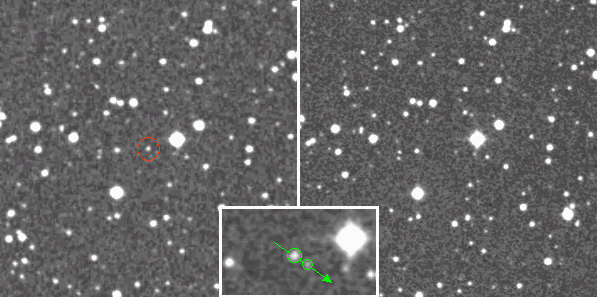
Digidized Sky Survey: Copyright and Acknowledgements.
In his report to the Minor Planet Center, Reiner Stoss noted that "this TNO is even as star in the USNO-B1.0 catalogue. I guess because it was within a certain radius on the blue and red plate from 1954 11 23, it was mistaken as a star. That's why I had to look a few times at the plate to identify it because the stars are flagged and usually I do not look at them if they are on one plate and not on the comparison plate." A query of the USNO-B1.0 star catalogue shows that the object, designated as 1121-0125248, was not only detected the blue and red-sensitive plates of the first Palomar Observatory Sky Survey (POSS-I) in 1954, as suggested by Stoss, but also on the blue, red and near-inrared plates of POSS-II, taken about 35 years later. But how could 1121-0125248 be 2004 DW if it was still there when the POSS-II plates were exposed?

The image aboves compares the red-sensitive POSS-I plate (left) with the respective image from the POSS-II. Obviously, 2004 DW is present on the POSS-I image (it is marked by a red circle in the image above), and there is no trace of it on the POSS-II plate. Note, however, the faint star located west-southwest (lower-right) of 2004 DW. Du to the improved photographic emulsion used for the newer survey, the star is more clearly visible in the right image. When compiling the USNO-B star catalogue, the image of 2004 DW on the older plate, and the detection of the star on the newer plate have apparently been matched, resulting in the catalogue entry for 1121-0125248, which lists a proper motion of ~0.21" per year, resulting from the ~7" positional difference between the image of the planetoid and the star, divided by the time between the two surveys. The inset at bottom center shows the image of 2004 DW from the POSS-I plate copied into the image extracted from the POSS-II plate, and the arrow indicates the proper motion vector taht was calculated from matching these two unrelated objects.